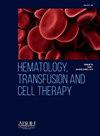COMPARATIVE RADIOLABELING OF THE CYCLIC PEPTIDE CTHRSSVVC WITH [68GA]GALLIUM AND [18F]FLUORINE. A POTENTIAL PROBE FOR MOLECULAR IMAGING OF CD163⁺ MACROPHAGES
IF 1.8
Q3 HEMATOLOGY
引用次数: 0
Abstract
Introduction/Justification
CD163⁺ macrophages play a critical role in chronic inflammation, cancer, and hematologic disorders, making them a promising target for molecular imaging. These cells contribute to tumor immunosuppression, disease progression, and poor prognosis in solid and hematologic tumors. Recent studies indicate that CD163 is a relevant biomarker in Hodgkin's lymphoma, multiple myeloma, and leukemias, which are directly associated with tumor resistance and immune evasion. The cyclic peptide CTHRSSVVC has been identified as a CD163 ligand, showing high reactivity with inflammatory and atherosclerotic lesions, suggesting its potential for targeting CD163⁺ macrophages. In vitro assays demonstrated that [111In]In-DOTA-CTHRSSVVC binds to atherosclerotic plaques, further supporting its applicability in molecular imaging of inflammation and cancer. Cyclic peptides are widely used in radiotracer development due to their high specificity, enzymatic stability, and resistance to degradation. Radiolabeling of these peptides with PET radioisotopes such as 68Ga3+ and [¹⁸F]AlF2+ expands their potential applications in tracking inflammatory processes and hematologic malignancies.
Objectives
To evaluate the radiolabeling efficiency and chemical stability of the NOTA-CTHRSSVVC cyclic peptide with 68Ga3+ and [18F]AlF2+, aiming to develop a novel radiopharmaceutical for molecular imaging of CD163⁺ macrophages.
Materials and Methods
The NOTA-CTHRSSVVC conjugate was radiolabeled [68Ga]Ga(AcO)3 or [18F]AlF2+, which were prepared in 0.2 M sodium acetate buffer (pH 4.1); reactions carried out under different peptide amounts. When necessary, the final products were purified using solid phase columns. The radiochemical efficiency was assessed by HPLC coupled with a gamma radiation detector, while chemical stability was evaluated in the labeling solution for up to 4 hours. The partition coefficient (logP) was determined in n-octanol/water system, in triplicate.
Results
The NOTA-CTHRSSVVC peptide was successfully radiolabeled and purified with the [68Ga]Ga-NOTA-CTHRSSVVC exhibited a radiochemical purity of 97.8% (n = 3), while [18F]AlF-NOTA-CTHRSSVVC reached 95.5% (n = 3). Both radiolabeled peptides demonstrated high chemical stability, maintaining their integrity for up to 4 hours in physiological solution. The logP analysis indicated a hydrophilic profile with the value of -3.08 ± 0.16.
Conclusion
The radiolabeling of the NOTA-CTHRSSVVC peptide with 68Ga3+ and [18F]AlF2+ was efficient and stable, demonstrating chemical feasibility for the development of a novel radiopharmaceutical. Given the potential interaction of the peptide with CD163, future investigations may focus on assessing its biological affinity and molecular imaging applications for CD163⁺ macrophages in hematologic and inflammatory diseases.
求助全文
约1分钟内获得全文
求助全文
来源期刊

Hematology, Transfusion and Cell Therapy
Multiple-
CiteScore
2.40
自引率
4.80%
发文量
1419
审稿时长
30 weeks
 求助内容:
求助内容: 应助结果提醒方式:
应助结果提醒方式:


